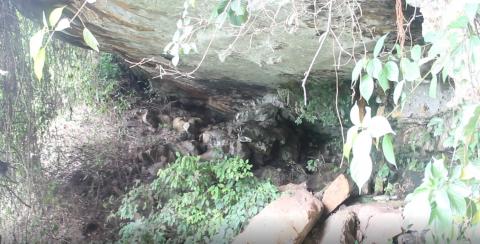TOURISM
Tourism
It is a multifaceted phenomenon encompassing the activities of people traveling to and staying in places outside their usual environment for leisure, business, or other purposes, for a period not exceeding one consecutive year. It is a dynamic and evolving industry that involves a complex interplay of travelers, destinations, businesses, and environments.
Key aspects of tourism:
Core Elements: Travelers (Visitors): Individuals or groups undertaking a journey to a different location. They can be classified as: Tourists: Staying in a place for at least 24 hours. Excursionists (Same-day visitors): Visiting a place for less than 24 hours. Domestic Tourists: Residents traveling within their own country. Inbound Tourists: Non-residents traveling to a specific country. Outbound Tourists: Residents of a country traveling to another country. Destination: The place visited by tourists, which offers attractions, facilities, and services.
Purpose of Travel: The motivation behind the trip, which can include: Leisure and Recreation: Holidays, relaxation, sightseeing, hobbies. Business and Professional: Meetings, conferences, trade shows, work-related travel. Other Purposes: Health, education, religious pilgrimages, visiting friends and relatives. Tourism Industry: The collection of businesses and organizations that provide goods and services to tourists, including: Accommodation: Hotels, resorts, guesthouses, rentals. Transportation: Airlines, trains, buses, car rentals, cruise lines. Food and Beverage: Restaurants, cafes, bars. Attractions: Natural sites, cultural sites, museums, theme parks, and events. Travel Services: Tour operators, travel agents, tourist information centers. Recreation and Entertainment: Activities, tours, shows.
Types of Tourism:
The tourism sector is incredibly diverse, with numerous specialized forms catering to different interests and motivations. Some common types include: Cultural Tourism focuses on experiencing a destination's culture, heritage, and lifestyle, including historical sites, museums, festivals, and local traditions. For example, visiting the Great Wall of China or attending a traditional Ugandan music and dance performance in Mbale.
Nature-Based Tourism (Ecotourism): Emphasizes travel to natural areas, promoting conservation and benefiting local communities. Examples include gorilla trekking in Bwindi Impenetrable National Park or bird watching in a local forest near Mbale.
Adventure Tourism: Involves travel to engage in physically challenging or adventurous activities, such as mountain climbing, white-water rafting, or zip-lining. The Rwenzori Mountains near Mbale offer opportunities for hiking and mountaineering.
Business Tourism (MICE - Meetings, Incentives, Conferences, and Exhibitions): Travel for professional purposes, including attending conferences at the Mbale Resort Hotel.
Medical Tourism: Traveling to another country for medical treatment or wellness purposes.
Religious Tourism: Travel motivated by religious or spiritual reasons, such as pilgrimages to holy sites. Agritourism: Visiting farms and rural areas to experience agricultural activities and rural life.
Culinary Tourism: Focuses on experiencing the food and drink of a destination. Trying "malewa" (a traditional Bagisu dish) in a local restaurant in Mbale would be an example.
Sports Tourism: Traveling to participate in or watch sporting events
Historical background of imbalu among the Bamasaba
Bamasaaba are a people who occupy a place called Masaabaland found at the slopes of Mt. Masaaba, also called Mt. Elgon. Masaabaland is a place that cuts across two nations - Uganda and Kenya.
The grandfather of Bamasaaba is Masaaba, son of Mundu and Seera who lived in Khaukha Cave in Mt. Masaaba. Mundu and Seera is a legendary couple that came to be the birthroot of Bamasaaba.
Masaaba gave birth to three sons, Mwambu, Mubuuya and Wanaale, who in turn gave birth to the 26 clans that form the cultural institution called Inzu ya Masaaba.
Bamasaaba are a population of over seven million people that inhabit the region across Mt. Masaaba; in Eastern Uganda and Western Kenya. They occupy the districts of Mbale, Sironko, Manafwa, Bududa, Bulambuli and Namisindwa in Uganda; and Bungoma and Trans Nzoia counties in Kenya. Bamasaaba are commonly known as Bagisu in Uganda and Babukusu in Kenya.
Why Bagisu?
Bagisu is plural, the singular of which is Mugisu. The name is derived from the eldest son of Masaaba called Mwambu.
History has it that Mwambu, while herding his father's cattle, was attacked by the dreaded Masai herdsmen who raided his cattle. He pursued them until they surrendered all the cattle and included a bull, “Ingisu,” in reward of his bravery. Ingisu is Masai word meaning a fat bull.
When Masaaba heard of Mwambu's episode and the resultant nickname, he called him Mugisu - a name to be remembered forever for his son's brave persona.
So, Mugisu is a name associated with Bravery. The courageous character of Bamasaaba/Bagisu is attributed to our association with Mwambu.
The Genesis of Imbalu
-------------
The history and origin of Imbalu is traced from Nabarwa, a Murwa girl of Burwa clan of the Kalenjin people in Masailand of Kenya. That is why we swear by “Imbalu ya Nabarwa” and not “Imbalu ya Mundu” nor “Imbalu ya Masaaba.”
Why? The story is told that as young Barwa girls of the Masai tribe were playing in their homestead, they saw a smoke in a far distance, far away from their home. The girls picked an argument among themselves and argued as to whether it was possible for anyone of them to run and reach the fireplace and return.
At the height of the argument, one brave blonde called Nabarwa offered to take the risk. She immediately started to journey into the unknown. She ran as fast as her legs could lift her, as her friends watched in bewilderment. She ran as her image diminished further and further - until she completely disappeared from her watchers. Nabarwa ran until she got lost into the forest of Mt. Masaaba.
Deep in the forest, Nabarwa met Fuuya, the great hunter, son of Mukhama of Mutoto clan. Fuuya looked in full admiration of a strange beautiful girl standing before him. He looked at the whole anatomy of Nabarwa and instantly fell in love. Nabarwa too was smitten by the brave-handsome-muscled man standing in the wild. She couldn’t resist the love offer.
As the lovebirds were about to eat the fruit of the Garden of Eden, Nabarwa discovered that Fuuya was not circumcised as was required by the custom of her tribe. He was a boy with a full skin covering his mantle.
“Nooo. You cannot taste the fruit of life with that whistle on. You should circumcise first,” Nabarwa advised her lover. Because of the burning love for the Murwa belle, Fuuya obliged.
He was then taken to Burwa and was circumcised according to the customs of the Barwa people. He was treated with Inguwu, a powerful local herb, and was healed within weeks. The healing left a scar on the weapon of love that created adorable feeling during the encounter.
However, Imbalu did not catch on immediately. It was not until Fuuya’s sons caught a rare life-threatening disease that the custom caught the attention of the descendants of Masaaba.
When Aramunyenye, the brother-in-law to Fuuya, a maternal uncle to the sons of Fuuya, visited his sister and found his nephews on the brink of death, he upon examination discovered that the spirit of Imbalu was afflicting the boys. He recommended circumcision according to the customs of the land in order to restore their health.
Thus, the boys were initiated and upon recovery, their health was restored to completeness. The boys became men, built own homes, married and started own families. Neighbours were wowed. They were surprised and equally excited. They voluntarily surrendered to the act of the knife that cured Fuuya’s sons.
Neighboring communities followed, and so were the neighboring communities. Imbalu news spread like bush fire. It was not long before the custom spread throughout Masaabaland.
Since then, upto this today and to the future, Imbalu remains an imperishable custom among BaMasaaba.
A boy undergoing circumcision in Mbale District in 2024
BAAMASAABA CULTURAL DANCES
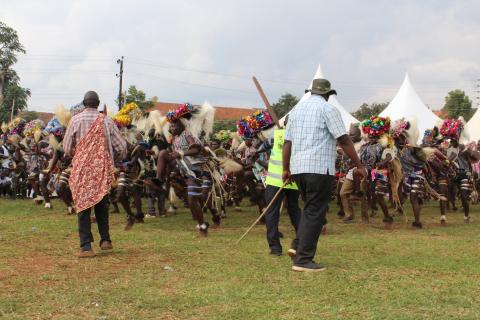
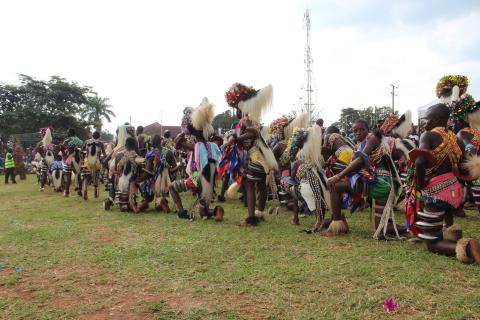
Wanale hill-Mbale’s hidden gem
Nestled in the eastern region of Uganda, Wanale Hill, which rises majestically on the outskirts of Mbale, is a captivating attraction that offers a truly breathtaking experience for visitors.
At first glance, one might mistake Wanale Hill for just another ordinary hill. However, as one begins to explore its wonders, they soon realise that it holds a wealth of natural beauty, history, and spiritual significance.
One of the most remarkable features of the hill is its lush greenery and diverse flora and fauna. You will be greeted by a verdant forest teeming with a variety of plant species.
The air is filled with the sweet aroma of flowers and the melodious chirping of birds, creating a serene atmosphere.
For nature enthusiasts and adventurous souls, Wanale Hill offers an extensive network of hiking trails. These trails run through the heart of the hill, unveiling breathtaking panoramic views of Mbale town and the surrounding landscapes at every turn.
As you ascend, you will be rewarded with stunning vistas of the sprawling plains, distant mountains, and the gentle curves of the winding Sipi River.
Wanale Hill isn’t just about its natural beauty. It is also steeped in history and cultural significance. According to local folklore, the hill is believed to be an ancient burial ground for the indigenous Imbalu tribal community.
Imbalu is a traditional circumcision ritual that marks the transition of boys into manhood. Wanale Hill, therefore, holds immense cultural importance as a sacred site for the Imbalu initiation ceremony.
Atop the hill, you will find Wanale Rock, a massive boulder that has stood proudly for centuries.
This rock serves as a symbol of strength and endurance for the local community. It is said that those who climb atop Wanale Rock will be granted good fortune and prosperity.
Aside from its natural and cultural significance, Wanale Hill also offers a spiritual experience for those seeking solace and peace.
The hill is dotted with small prayer huts and meditation spots, providing a serene environment for reflection and self-discovery.
Many visitors come to Wanale Hill to reconnect with nature and find inner harmony through meditation and contemplation.
For those looking for a bit of adventure, Wanale Hill offers an exciting opportunity for paragliding.
Professional paragliding instructors guide thrill-seekers as they glide through the air, capturing stunning aerial views of Mbale and its surroundings.
This adrenaline-inducing activity allows you to experience Wanale Hill from a whole new perspective as you soar gracefully above the lush landscape.
As you descend from Wanale Hill, do not forget to visit the nearby Wanale Waterfall. Situated in a secluded corner, this mesmerizing cascade adds an extra touch of magic and tranquilly to your experience.
The sight and sound of the water tumbling down the rocks is truly enchanting and provides the perfect backdrop for a relaxing picnic or a moment of quiet contemplation.
So, next time you find yourself in Mbale, do not miss the opportunity to explore this amazing destination and uncover the wonders of Wanale Hill.
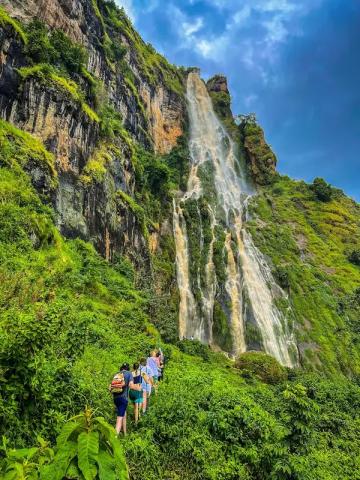
COMMUNITY WALK TO WANALE HILL
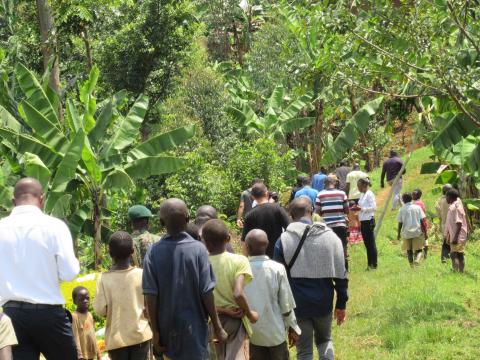
CAVES IN WANALE
wamangono cave WATSIBEENI CAVE
